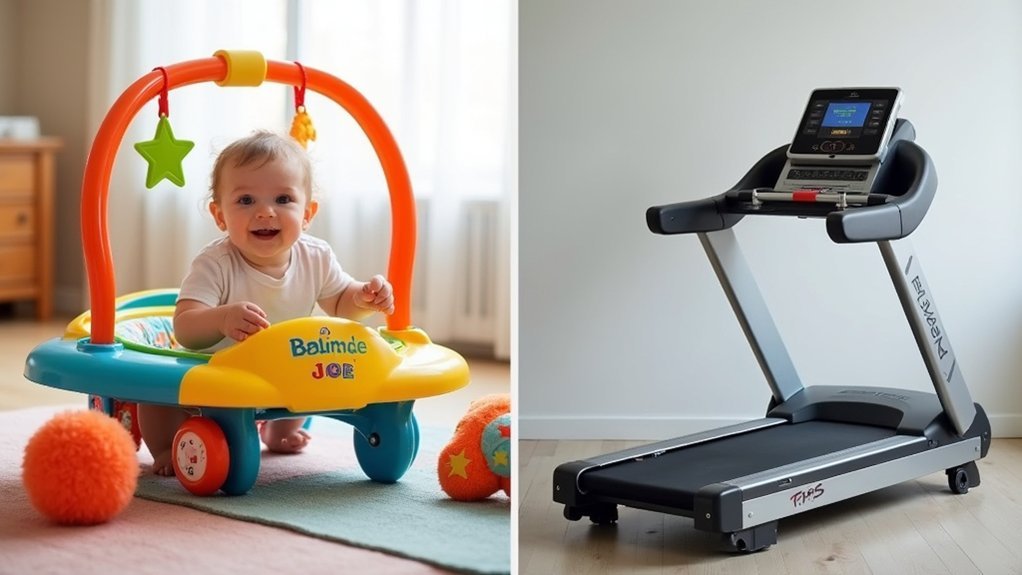Mini bouncers offer 68% more effective cardiovascular conditioning than treadmills while burning 50% more calories. They absorb 80% of impact force, making them gentler on joints. You’ll need just 3-4 feet of space compared to a treadmill’s 5×7 foot area, and they’re typically more affordable ($100-$400 vs. $300-$3,000+). The playful nature of bouncing also improves workout adherence and targets more muscle groups. Our comparison reveals surprising benefits beyond these impressive numbers.
The Science Behind Mini Bouncer Exercise Vs Traditional Running

While traditional running has long been considered the gold standard for cardiovascular exercise, mini bouncers (or rebounders) have emerged as a scientifically superior alternative.
NASA research demonstrates that rebounding for just 10 minutes delivers the same cardiovascular health benefits as 33 minutes of running. This efficiency translates to your calorie burn too—a mini trampoline workout torches approximately 50% more calories than treadmill sessions.
What’s particularly revolutionary is how rebounding protects your body. The mini trampoline absorbs over 80% of impact, preventing joint problems that commonly plague runners.
Unlike treadmill exercise that primarily works your lower body, rebounding engages multiple muscle groups simultaneously, enhancing overall strength, balance, and coordination.
You’ll achieve comparable cardiovascular improvements in just one-third of the time, making rebounding the smarter choice for time-efficient, full-body conditioning.
Calorie Burning Efficiency: Mini Bouncers Vs Treadmills
You’ll burn roughly the same calories on both a mini bouncer and treadmill at 300-350 calories per half hour, but NASA research shows rebounding is 68% more effective for cardiovascular fitness.
The mini bouncer’s advantage comes from engaging your upper body simultaneously, whereas treadmills primarily work your lower body.
What’s most impressive is that just two minutes of rebounding equals six minutes of treadmill running in cardiovascular benefits, making mini bouncers notably more time-efficient.
Burn Rate Comparison
How effectively does your workout equipment torch calories? When comparing mini bouncers to treadmills, the numbers tell an impressive story. Rebounding consistently outperforms treadmill running for weight loss and cardiovascular workout efficiency.
- Time efficiency: NASA research shows just 10 minutes of jumping on a trampoline equals 33 minutes of treadmill running—making rebounding extraordinarily efficient for busy schedules.
- Higher calorie burn: Rebounding burns calories at a rate 50% higher than treadmill workouts, with 30-minute sessions consuming approximately 234 calories versus 218 for running.
- Joint-friendly results: You’ll achieve superior calorie burning (300-350 calories per 30 minutes) with considerably less impact on your joints, reducing injury risk while maximizing weight loss benefits.
Workout Efficiency Metrics
Numbers don’t lie when comparing workout efficiency between mini bouncers and treadmills. When you choose rebounding, you’re getting approximately 50% more calorie burn than traditional treadmill workouts in the same timeframe.
NASA research confirms this efficiency, showing that 10 minutes on a mini bouncer delivers equivalent cardiovascular benefits to 30 minutes of running.
In practical terms, a 30-minute rebounding session burns about 234 calories compared to only 218 calories during treadmill exercise at a similar intensity.
The math is compelling: two minutes of bouncing equals six minutes of running in workout effectiveness.
This superior efficiency, combined with the enjoyable nature of rebounding, means you’re more likely to stick with your fitness routine long-term—maximizing your results while minimizing your time investment.
Joint Impact and Safety Considerations for Both Workout Methods

While both mini bouncers and treadmills offer excellent cardiovascular benefits, they differ dramatically in their impact on your joints and overall safety profile.
Mini bouncers absorb over 80% of impact force, making them ideal for low-impact exercise that protects your knees, ankles, and hips.
- Joint-Friendly Design – NASA research shows that 10 minutes on a mini bouncer delivers more cardiovascular benefit than 33 minutes of treadmill running, with considerably less joint stress.
- Injury Prevention – Treadmills commonly cause knee pain and blisters from repetitive impact, while mini bouncers reduce injury risk when proper safety precautions are followed.
- Safety Features – Mini bouncers typically include safety nets and padded frames, whereas treadmills require careful attention to prevent falls and chronic joint problems.
Space Requirements and Home Setup Comparisons
When comparing workout equipment for your home, space considerations often determine what’s practical for your living situation.
Mini bouncers offer a compact footprint of just 3-4 feet in diameter and can be folded away after use, while treadmills typically require a dedicated 5×7 foot area that remains occupied even when not in use.
If you’re working with limited square footage, you’ll find several small-space setup solutions for mini bouncers, including wall mounting options and vertical storage stands that simply aren’t available for most treadmill models.
Footprint Comparison Chart
Before investing in exercise equipment for your home, understanding the space requirements can save you significant frustration.
Mini bouncers offer a compact alternative to bulky treadmills, with a typical footprint of just 4′ x 4′ compared to the 6′ x 3′ or larger space treadmills demand.
- Size Difference: Mini bouncers require approximately 16 square feet of exercise space, while treadmills need 18+ square feet plus additional clearance for safety.
- Portability Factor: At 15-25 pounds, mini bouncers can be easily relocated, unlike treadmills weighing 150-300 pounds that resist frequent transport.
- Storage Options: Foldable mini bouncers can slip under beds or into closets when not in use, whereas treadmills typically require dedicated, permanent space even with folding models.
Small-Space Setup Solutions
Setting up fitness equipment in a confined living space demands creative thinking and practical solutions. Mini bouncers shine in small-space environments, requiring just a 3×3 foot area compared to the 6×3 feet needed for treadmills. You’ll find setup time dramatically reduced with bouncers—often ready in minutes versus the lengthy assembly treadmills require.
| Feature | Mini Bouncers | Treadmills |
|---|---|---|
| Space Required | 3′ × 3′ | 6′ × 3′ |
| Weight | 20-30 lbs | 150+ lbs |
| Storage Options | Foldable, fits under beds/in closets | Requires dedicated space |
| Setup Time | Minutes | Hours (assembly required) |
When planning your home fitness area, consider how you’ll store equipment when not in use. Mini bouncers’ lightweight design (20-30 pounds) makes them portable enough to move between rooms, while treadmills remain stationary due to their substantial weight.
Cost Analysis: Initial Investment and Long-Term Value

Although both fitness options require an upfront investment, mini bouncers typically offer a more budget-friendly entry point than treadmills. While quality mini bouncers range from $100-$400, treadmills can cost anywhere from $300 to upwards of $3,000 depending on features.
Mini bouncers provide an affordable fitness solution at $100-$400, while treadmills can run upwards of $3,000 for premium models.
When considering long-term value, mini bouncers excel in three key areas:
- Minimal maintenance costs – Unlike treadmills that require belt lubrication and potential part replacements, bouncers have virtually no ongoing expenses.
- Space efficiency – Their compact footprint makes them ideal for home use without dedicated gym space.
- Higher fitness adherence – The fun, engaging nature of rebounding often leads to more consistent use, maximizing your investment.
The affordability and durability of mini bouncers ultimately deliver better long-term value for most home fitness enthusiasts.
Workout Variety and Muscle Engagement Differences
While treadmills offer a straightforward walking or running experience, mini bouncers deliver considerably more diverse workout possibilities with superior muscle engagement.
You’ll activate multiple muscle groups, especially your core and lower body, during rebounding sessions, whereas treadmill running primarily targets your legs.
Mini bouncers allow you to bounce, twist, and jump while simultaneously incorporating upper body exercises, creating a full-body workout experience that treadmills simply can’t match.
NASA research confirms this efficiency, showing that two minutes of rebounding equals six minutes of running.
Additionally, you’ll improve your balance and coordination through the dynamic movements on a mini bouncer.
Treadmill workouts, with their consistent flat surface, may actually reduce your agility over time, limiting your overall fitness development.
Cardiovascular Benefits: What Research Reveals About Both Options
The cardiovascular benefits of mini bouncers stand out dramatically in research comparisons with treadmills. NASA research found rebounding is 68% more effective than running on a treadmill for cardiovascular conditioning. Your body benefits more while experiencing less stress on your joints.
When comparing calorie-burning potential:
- A 150-pound person burns 82 calories during 12 minutes of trampolining versus 71 calories jogging at 5 mph.
- A full hour of rebounding equals three hours of running in cardiovascular benefits.
- Trampoline workouts engage multiple muscle groups simultaneously, enhancing your coordination while strengthening your heart.
You’ll get more efficient cardiovascular training with mini bouncers while protecting your joints from the high-impact stress associated with treadmill running—making trampolines the superior option for sustainable heart health.
Mental Health and Enjoyment Factors in Exercise Adherence
Why do most fitness routines fail within weeks? The answer often lies in enjoyment—or lack thereof. Research confirms you’re more likely to stick with exercise when it’s fun rather than a chore.
Mini bouncers offer a playful alternative to traditional workouts. Trampoline workouts feel less like exercise and more like recreation, reducing your perceived exertion while delivering serious benefits. This enjoyment factor translates directly to improved exercise adherence.
Beyond physical benefits, bouncing can greatly boost your mental health through stress reduction and mood improvement. Studies show these positive outcomes create a healthier relationship with fitness, encouraging long-term commitment.
Meanwhile, treadmill routines, while effective, often lack the inherent fun factor that makes you enthusiastic to return day after day.
Making Your Choice: Who Benefits Most From Each Equipment Type
Selecting the right fitness equipment means aligning your personal needs with the unique benefits each option offers. When deciding between mini bouncers and treadmills, consider your body’s needs and fitness objectives.
- Joint health seekers – Mini bouncers provide a low-impact workout that absorbs over 80% of impact forces, making them ideal if you’re concerned about joint stress that typically comes with treadmill running.
- Calorie-burning enthusiasts – If maximizing calorie burn in shorter workout sessions is your priority, mini bouncers deliver more efficient results than treadmills while engaging multiple muscle groups simultaneously.
- Traditional runners – You’ll benefit more from a treadmill if you prefer controlled environments with customizable settings that simulate outdoor running conditions while primarily targeting leg muscles.
Frequently Asked Questions
Is a Rebounder Better Than a Treadmill?
Yes, a rebounder is better than a treadmill. You’ll burn more calories, enjoy gentler impact on your joints, and get a full-body workout. NASA’s research shows it’s 68% more efficient for cardiovascular fitness.
What Is 10 Minutes on a Rebounder Equivalent To?
Ten minutes on a rebounder is equivalent to about 30 minutes of treadmill running. You’ll get a more efficient cardiovascular workout that burns more calories while saving time on your fitness journey.
Can You Lose Belly Fat on a Mini Trampoline?
Yes, you can lose belly fat on a mini trampoline. It engages your core muscles, burns calories efficiently, and improves your metabolism. Consistent rebounding, paired with healthy eating, will help reduce your waistline over time.
How Much Walking Is 10 Minutes of Rebounding Equal To?
Ten minutes of rebounding equals about 33 minutes of walking. You’ll get similar cardiovascular benefits in less time, while also enjoying reduced joint impact compared to your regular walking routine.
In Summary
Ultimately, you’ll need to weigh what matters most to your fitness journey. Mini bouncers offer low-impact, space-efficient workouts that engage multiple muscles, while treadmills provide proven cardio benefits with trackable metrics. Consider your joint health, space constraints, budget, and exercise preferences. Both can transform your fitness routine—choose the option that you’ll consistently use and enjoy for lasting results.





Leave a Reply